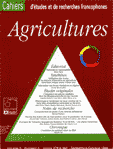Phénologie et rendement de deux variétés de riz dans deux écosystèmes contrastés au Burundi
Résumé
Whereas cold temperatures induce rice sterility and promote bacterial sheath rot due to Pseudomonas fuscovaginae, a slightly warmer climate promotes fungal sheath rot due to Sarocladium oryzae. To reduce disease-based losses, good panicle exsertion is required ; at present, only a few tall varieties are satisfactory in this respect. The Kurundo 3 and 9 varieties (K3 : a « japonica » type, and K9 : an «indica» type) were compared in two different ecological situations : one, Bukemba, at 1,200 metres above sea level, the other, Musagara, at 1,680 m. Rice was transplanted in a swampy valley with abundant pools, irrigated and fertilised during the rainy season with 60-80-60 NPK. 180 hills on each site were evaluated phenologically every week for each variety using the Zadok's scale. For the analysis of variance, certain aberrant hills were eliminated. The duration, sum of degree-hours, threshold temperature and sum of solar radiation of each stage were based on the population mode. Low temperatures caused a problem at all growth stages at Musagara. The threshold temperature was identified by iteration, by calculating the number of degree-hours for each day above different thresholds to obtain thé same sum in both sites. The first result of importance to be obtained was that the growth stages were independent of cold resistance. This suggests that breeding for improved cold tolerance is possible. Cold and solar radiation affected the two species' yields in different ways (Table 3). This study represents initial groundwork in a crop improvement programme. Hopefully, a cross between the K3 and K9 varieties could result in an ideotype suited to high altitudes. Last year, however, both varieties growing at an altitude of around 1,450 m proved susceptible to leaf and neek blast. Since no symptom of blast or fungal sheath rot was observed in either site, understanding the interactions between climate, variety and pathogen in these field experiments was not easy. The bulk population method with rapid generations at low altitude, followed by natural selection of F6 at 1,550 m, gave good results, with the multi-polygenic system controlling cold tolerance.Publié
1994-09-01
Comment citer
Tilquin, J.-P., Sibomana, C., Evrard, D., Busogoro, J.-P., & Detry, J.-F. (1994). Phénologie et rendement de deux variétés de riz dans deux écosystèmes contrastés au Burundi. Cahiers Agricultures, 3(5), 309–314 (1). Consulté à l’adresse https://revues.cirad.fr/index.php/cahiers-agricultures/article/view/29851
Numéro
Rubrique
Articles

